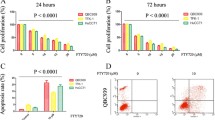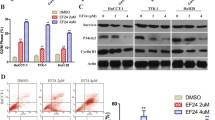Abstract
Intrahepatic cholangiocarcinoma (ICC) has been reported to be the second most common primary hepatic carcinoma worldwide, and very limited therapies are currently available. Serine threonine tyrosine kinase (STYK1), a member of the receptor tyrosine kinase family, exhibits tumorigenicity in many types of cancers and is a potential therapeutic target for ICC. In this study, STYK1 was knocked down in the ICC cell lines HCCC-9810 and RBE via a lentivirus-mediated system using short hairpin RNA (shRNA). Next, cell proliferation, colony formation, cell cycle progression, tumor formation in nude mice, migration and invasion, and the expression levels of cell cycle proteins in Lv-sh STYK1- or Lv-sh Con-infected cells were analyzed by CCK-8 assay, colony formation evaluation, flow cytometry, tumor formation evaluation, wound scratch assay, transwell assay, and western blotting. The results indicated that depletion of STYK1 inhibits ICC development both in vitro and in vivo.







Similar content being viewed by others
References
Suzuki H, Komuta M, Bolog A, Yokobori T, Wada S, Araki K, Kubo N, Watanabe A, Tsukagoshi M, Kuwano H. Relationship between 18-f-fluoro-deoxy-d-glucose uptake and expression of glucose transporter 1 and pyruvate kinase m2 in intrahepatic cholangiocarcinoma. Dig Liver Dis. 2015;47:590–6.
Hubbard SR, Till JH. Protein tyrosine kinase structure and function. Annu Rev Biochem. 2000;69:373–98.
Robinson DR, YM W, Lin SF. The protein tyrosine kinase family of the human genome. Oncogene. 2000;19:5548–57.
Zwick E, Bange J, Ullrich A. Receptor tyrosine kinase signalling as a target for cancer intervention strategies. Endocr Relat Cancer. 2001;8:161–73.
Chen P, Li WM, Lu Q, Wang J, Yan XL, Zhang ZP, Li XF. Clinicopathologic features and prognostic implications of NOK/STYK1 protein expression in non-small cell lung cancer. BMC Cancer. 2014;14:402.
Liu L, XZ Y, Li TS, Song LX, Chen PL, Suo TL, Li YH, Wang SD, Chen Y, Ren YM, Zhang SP, Chang ZJ, Fu XY. A novel protein tyrosine kinase NOK that shares homology with platelet- derived growth factor/fibroblast growth factor receptors induces tumorigenesis and metastasis in nude mice. Cancer Res. 2004;64:3491–9.
Fambrough D, McClure K, Kazlauskas A, Lander ES. Diverse signaling pathways activated by growth factor receptors induce broadly overlapping, rather than independent, sets of genes. Cell. 1999;97:727–41.
Chen Y, Li YH, Chen XP, Gong LM, Zhang SP, Chang ZJ, Zhang XF, XY F, Liu L. Point mutation at single tyrosine residue of novel oncogene NOK abrogates tumorigenesis in nude mice. Cancer Res. 2005;65:10838–46.
Li YH, Wang YY, Zhong S, Rong ZL, Ren YM, Li ZY, Zhang SP, Chang ZJ, Liu L. Transmembrane helix of novel oncogene with kinase-domain (NOK) influences its oligomerization and limits the activation of RAS/MPAK signaling. Mol Cell. 2009;27:39–45.
Ding X, Jiang QB, Li R, Chen S, Zhang S. NOK/STYK1 has a strong tendency towards forming aggregates and colocalises with epidermal growth factor receptor in endosomes. Biochem Biophys Res Commun. 2012;421:468–73.
Orang AV, Safaralizadeh R, Hosseinpour Feizi MA, Somi MH. Diagnostic relevance of overexpressed serine threonine tyrosine kinase/novel oncogene with kinase domain (STYK1/NOK) mRNA in colorectal cancer. Asian Pac J Cancer Prev. 2014;15:6685–9.
Amachika T, Kobayashi D, Moriai R, Tsuji N, Watanabe N. Diagnostic relevance of overexpressed mRNA of novel oncogene with kinase-domain (NOK) in lung cancers. Lung Cancer. 2007;56:337–40.
Kimbro KS, Duschene K, Willard M, Moore JA, Freeman S. A novel gene STYK1/NOK is upregulated in estrogen receptor-alpha negative estrogen receptor-beta positive breast cancer cells following estrogen treatment. Mol Biol Rep. 2008;35:23–7.
Jackson KA, Oprea G, Handy J, Kimbro KS. Aberrant STYK1 expression in ovarian cancer tissues and cell lines. J Ovarian Res. 2009;2:15.
BL Y, Peng XH, Zhao FP, Liu X, Lu J, Wang L, Li G, Chen HH, Li XP. MicroRNA-378 functions as an onco-miR in nasopharyngeal carcinoma by repressing TOB2 expression. Int J Oncol. 2014;44:1215–22.
Lee MM, Chen YY, Liu PY, Hsu S, Sheu MJ. Pipoxolan inhibits CL1-5 lung cancer cells migration and invasion through inhibition of MMP-9 and MMP-2. Chem Biol Interact. 2015;236:19–30.
Wang Z, Tang X, Zhang Y, Qi R, Li Z, Zhang K, Liu Z, Yang X. Lobaplatin induces apoptosis and arrests cell cycle progression in human cholangiocarcinoma cell line RBE. Biomedicine Pharmacother. 2012;66:161–6.
Shi RY, Yang XR, Shen QJ, Yang LX, Xu Y, Qiu SJ, Sun YF, Zhang X, Wang Z, Zhu K, Qin WX, Tang ZY, Fan J, Zhou J. High expression of Dickkopf-related protein 1 is related to lymphatic metastasis and indicates poor prognosis in intrahepatic cholangiocarcinoma patients after surgery. Cancer. 2013;119:993–1003.
Eriksson JE, Dechat T, Grin B, Helfand B, Mendez M, Pallari HM, Goldman RD. Introducing intermediate filaments: from discovery to disease. J Clin Invest. 2009;119:1763–71.
Cabeen MT, Jacobs-Wagner C. The bacterial cytoskeleton. Annu Rev Genet. 2010;44:365–92.
Goldman RD, Khuon S, Chou YH, Opal P, Steinert PM. The function of intermediate filaments in cell shape and cytoskeletal integrity. J Cell Biol. 1996;134:971–83.
Leader M, Collins M, Patel J, Henry K. Vimentin: an evaluation of its role as a tumour marker. Histopathology. 1987;11:63–72.
Ramis-Conde I, Chaplain MA, Anderson AR, Drasdo D. Multi-scale modelling of cancer cell intravasation: the role of cadherins in metastasis. Phys Biol. 2009;6:016008.
Yuan J, Yan R, Kramer A, Eckerdt F, Roller M, Kaufmann M, Strebhardt K. Cyclin b1 depletion inhibits proliferation and induces apoptosis in human tumor cells. Oncogene. 2004;23:5843–52.
Zhang F, Liu B, Wang Z, XJ Y, Ni QX, Yang WT, Mukaida N, Li YY. A novel regulatory mechanism of Pim-3 kinase stability and its involvement in pancreatic cancer progression. Mol Cancer Res. 2013;11:1508–20.
Lee MG, Nurse P. Complementation used to clone a human homologue of the fission yeast cell cycle control gene cdc2. Nature. 1987;327:31–5.
Kristjansdottir K, Rudolph J. Cdc25 phosphatases and cancer. Chem Biol. 2004;11:1043–51.
Canel M, Serrels A, Frame MC, Brunton VG. E-cadherin-integrin crosstalk in cancer invasion and metastasis. J Cell Sci. 2013;126:393–401.
Acknowledgments
This work was supported by the International Science and Technology Cooperation Program of China (No. 2014DFA31420) and the National Natural Science Foundation of China (No. 81160311).
Author information
Authors and Affiliations
Corresponding authors
Ethics declarations
All animal experiments were approved by the Animal Care Committee of the Affiliated Hospital of Guiyang Medical College.
Additional information
Mei-yuan Chen and Hao Zhang equally contribute to this study as the co-first authors.
Rights and permissions
About this article
Cite this article
Chen, My., Zhang, H., Jiang, Jx. et al. Depletion of STYK1 inhibits intrahepatic cholangiocarcinoma development both in vitro and in vivo. Tumor Biol. 37, 14173–14181 (2016). https://doi.org/10.1007/s13277-016-5188-6
Received:
Accepted:
Published:
Issue Date:
DOI: https://doi.org/10.1007/s13277-016-5188-6




